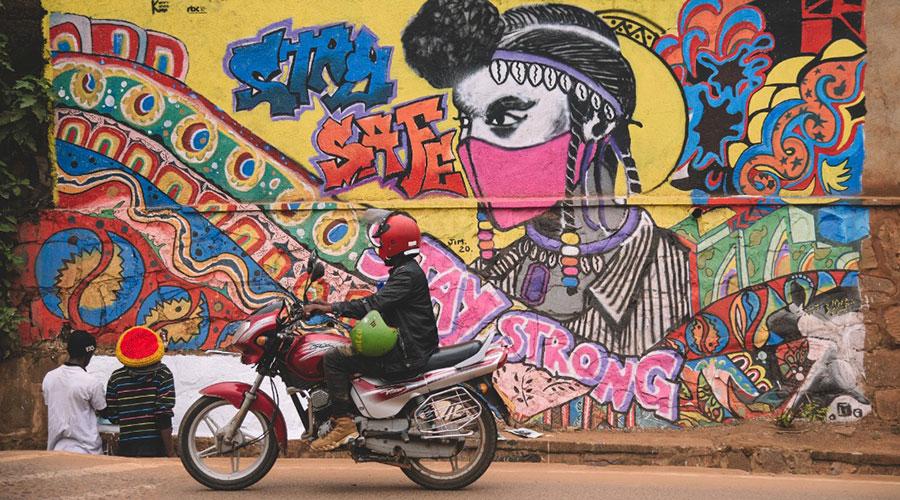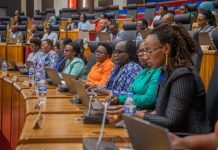Africa-Press – Rwanda. Murals are an opportunity to make bold statements. This is why established and aspiring artists alike have made their mark on Kigali City in the form of public murals and street art.
Some areas include Kiyovu at Impact hub, Kicukiro at Sonatube, Café de Rwampara, Kimisagara at Maison de jeune, and Remera at RBC to mention a few. According to culturepartnership.
eu, a mural is any piece of artwork painted or applied directly onto a wall, ceiling or other larger permanent surfaces, flat, concave or convex. They are notable for creativity, beauty, as well as for the powerful messages they portray.
The New Times
talked to different creatives behind some of these works of public art, tackling the importance of street arts as well as the significance of their messages.
Judith Kaine, the Founder of Kurema, Kureba, Kwiga which translates in English to “To Create, To See, To Learn”, is the director of Rwanda’s preeminent public-arts social enterprise and custom-art services provider. The organisation works with professional Rwandan artists, as well as visiting international artists.
She said that street art creates a way for artists to share their work with huge audiences, including people who may not have the opportunity or feel comfortable to visit art galleries, adding that its goal is not to sell that piece of art once it is already on the wall.
“Good street artists prioritize connecting with their audiences through their masterpieces, but the mechanism is different when it is a wall in a public space. It creates a different type of free expression,” she said. “Street art brings people together, hence beautifying as well as improving communities.
Whether it’s watching the work come to life while it’s being created, or when different people experience the art once it is made, street art offers an opportunity for them to connect with art and each other in a unique way.
”
Tackling the business side, she said that street art can increase the value of certain properties, bring more customers to businesses and ultimately connect the private experience of viewing art with the experience of public or civic engagement.
Street art, she continued, can also be socially impactful by sharing pertinent information that informs and influences public opinion on key issues; whether behaviour change, advocacy, political messaging etc, adding that it is a powerful tool of communication.
She also revealed that her organisation is developing more Covid-19 awareness murals and an educational mural concerning conservation and environmental protection to be implemented before the end of 2021.
Jim Rolland, a muralist, has created different murals at different places in Kigali. He shares the messages them some of them convey. “My murals are inspired by African culture.
Like in these times of Covid-19, I created a mural at Café de Rwampara, Gikondo and my message is of hope and resilience while encouraging people to take the right steps, like properly wearing masks, staying safe and above all, staying strong,” he said.
Jim was also among the artists who created a mural at Impact Hub in Kiyovu; a huge collabo with Rwandan and international artists led by Judith Kaine and artist Muntu621.
He said that it demonstrates a trip through history from the strong men of the past to the thousand beautiful hills as well as the rich nature and culture of Rwanda.
Referring to his piece within the larger artwork, Umusambi, he said that it is about nature and bird conservation and that the birds can be seen in their natural environment. He shared that he used a purple colour to emphasize their endangered species status.
A mural at Impact Hub in Kiyovu; a huge collabo with Rwandan and international artists led by Judith Kaine and artist Muntu621.
Peter Lee, The Founder and manager of Envision, an art organisation that have also worked on murals, also recognises that street art is important because it brings art and creativity to public spaces where it can be appreciated by the community.
“Because street art is usually painted on walls and buildings, the artists get a much larger canvas to express themselves in addition to reaching a much larger audience. I think the increase in street art is also a symbol of a community’s developing arts and culture industry,” he said.
“Street art in Rwanda seems to be getting more popular these days as artists, organisations, and businesses are seeing not only the beauty but the value of displaying large works of art in public spaces.
”
At Envision, located at Kicukiro, Sonatube, they have several murals in and around a multimedia studio space and cafe that have served many purposes for them.
“First, it serves as an identifying and branding symbol of who we are as an organization. Second, the beauty and colour of these large artworks create an atmosphere designed to inspire creativity,” he said.
“Lastly, these large public murals have served as advertising exposure for our artists who painted the murals.
They have since received several commissioned jobs based on a client seeing our mural from the road. ” Remy Iradukunda who worked on the above mentioned mural shares some of the messages it conveys.
“We wanted to work on all seasons that happen in Rwanda; spring, summer, cold season, etc; working day and night. When you look at it closely, it’s 360 degrees.
On one side where there is a face of a person and volcanoes, we wanted to demonstrate the coldness in the country as well as tourism attractions where we showed stuff like water, Kivu lake and a thousand hills,” he said.
“There is also a drawing of a Rwanda map with a camera in the centre.
On this, we wanted to highlight that one can show what they do without saying anything; what you do speaks by itself. On the other hand, it’s the logo of Envision.
” Iradukunda also worked on another mural which is located at Root Foundation in Nyarutarama. It is a mural of a woman with hair on head. He shared its meaning.
“I wanted to show the power of a woman, women’s empowerment and how people see her differently or weak while she has the power within herself.
I showed that she can do something big which can spread and boost stunningly,’ he said. “It depicts a tree and its roots obtain water that makes it grow. It must have beautiful leaves. That demonstrates the fruitage of that woman and refutes what people saw as something she couldn’t bear.”






